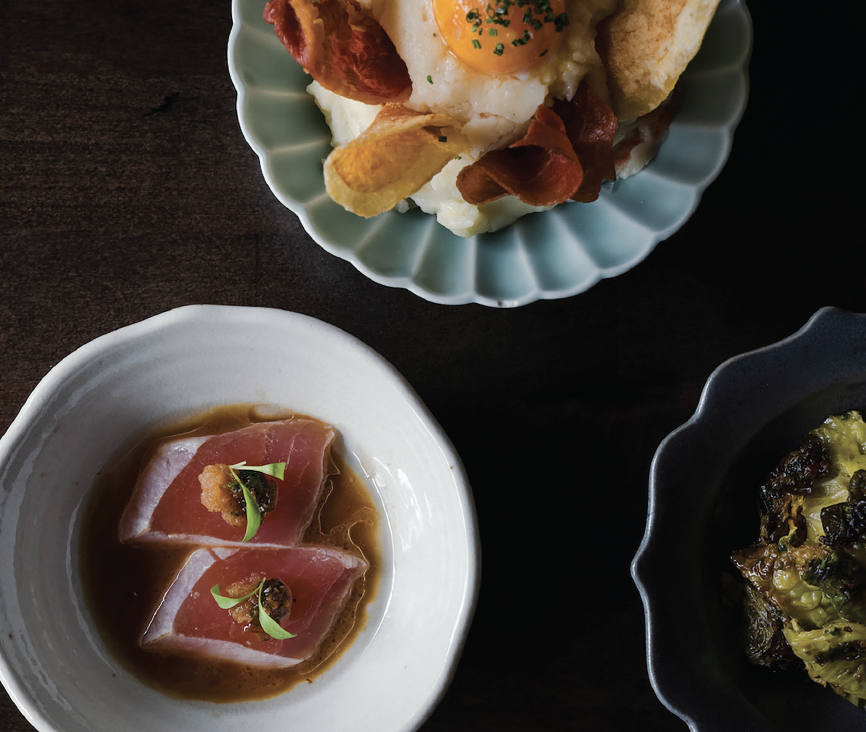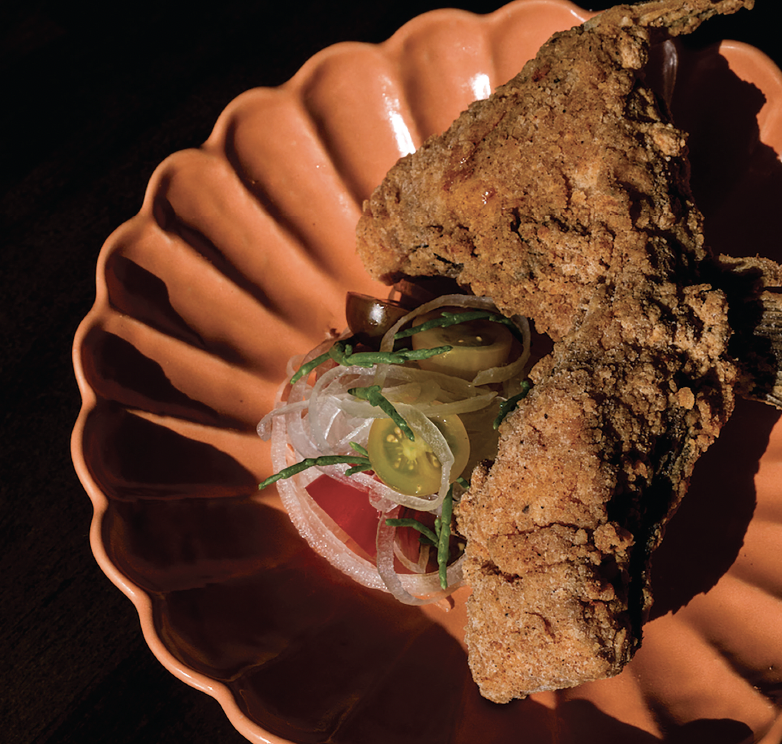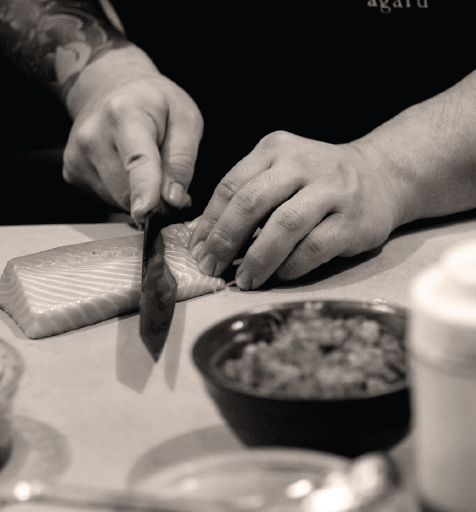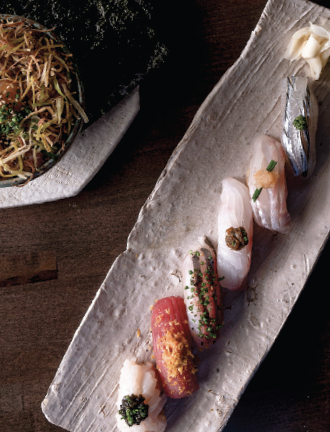Raising the Bar




Perched on the second floor of an obscure building along Royal Hawaiian Avenue, Izakaya Agaru — the dining space named after the Japanese word for “rise” or “improve” — furnishes an inventive Japanese pub experience and an atelier for a cultivated omakase encounter. Surrounding himself with a vetted team embracing the shokunin spirit and a sense of omotenashi, Chris Kajioka scales his hierarchy of needs as a maturing chef while rediscovering a sense of fun in the kitchen.
Equipped with a French and Moroccan culinary acumen, and an interminable love for Japanese food, Kajioka assembles a team to develop a series of small plates aligned with his evolving preferences. Collectively, they seek ways to refine their craft, while imparting their distinctive brand on the modern izakaya experience.
“Izakaya cuisine is my favorite thing to eat, and on my days off, (the izakaya is) where I like to go,” reveals Kajioka, who is recognized for forging elaborate and lavish presentations along the ecumenical lines of New American cuisine. “To me, the best way to eat is to have a lot of small different plates. The older I get, the less formal I want it to be, and I want it to be quicker.”
Understanding the need to produce portioned dishes expeditiously, Kajioka recruits Bob Luong as Chef de Cuisine. With some training working at ramen hops, Luong attributes his structured culinary aptitude to the now-shuttered NoMad in Los Angeles. Striving to reimagine traditional izakaya staples, he pushes the envelope with bolder seasonings balanced by the use of acid, while also using his technical skills to coax out flavors from the finest of ingredients.
“I start with a good product, apply great technique, and cook for flavor,” reveals Luong. “We do season aggressively, and with high acid.” Kajioka adds, “That’s the point of izakaya. Usually, you get one or two bites of everything, and those one or two bites need to be impactful.”
Aligned with this resolve is the kakuni, a sous vide section of pork finished on the binchotan grill. The adipose char lacquered with a molasses-like pomegranate and black garlic glaze elicits bold flavors that covets a sip of Koshihikari Echigo if not one of Agaru’s refreshing highballs such as the yuzu or shiso pineapple with Toki whiskey.
Another dish, the karaage, dredges chicken in potato and tapioca flour to induce a crisp skin that reveals plump, succulent morsels. Brightened by a squeeze of lemon, each bite is tempted with a gluttonous plunge into the smoked oyster aioli. The hamachi kama, battered along the lines of Southern fried chicken, is given a dose of acidity through a captivating finadene. An incarnation of Kajioka’s revered ahi toast is found on the ala carte menu, replacing brioche with Japanese milk bread and for a reasonable supplement, a sumptuous serving of Kaluga caviar. His signature cabbage dish, re-envisioned with shio konbu and salsa verde, also makes a cameo but in the 8-course $65 izakaya set as a seasonal vegetable.
An alternative experience with a few izakaya overlaps is discovered at the counter, helmed by Sushi Chef Daysen Masuda, a humble Hilo native esteemed for his cottage sushi. Emulating Japan’s sushi masters, he augments his dexterity with some unorthodox techniques to conjure up an ever-evolving omakase infused with provincial ingredients for $150 to $175.
“I have my black belt in jiu-jitsu and to the outside world, people see that as the end,” Masuda parallels to his culinary tenets. “In the martial arts world, you become a student again. You never truly can master something; you are always learning different techniques, other ways to do things.”
With a promising tone of culinarians earnestly prepared to gratify, our degustation embarks with a dashi-braised eggplant enlivened with kanzuri (fermented pepper and yuzu paste). Subtle essences crescendo to a fragrant piquance, stimulating the palate. Then, a triumvirate of umami-laden bites — buttery Kona kampachi kobujime tempered by a tosazu gelée, silken chawanmushi luxuriated with Hokkaido uni, foie gras, and a shimmering black truffle-flecked varnish, and a luscious slice of ankimo torchon mounted with a sliver of iburigakko (smoked pickled daikon) on toast — serve as precursors to the procession of nigiri served over blended koshihikari and nanatsuboshi rice.
Decorative morsels as scallop with lime zest, shima aji aburi with chive, madai dabbed with curry oroshi, chutoro with kaluga, and otoro topped with shaves of homemade uni bottarga, among others are presented in choreographed succession, the shari (rice balls) seasoned with a
variety of vinegars to punctuate the variegated flavour profiles of the neta (toppings).
Blue crab with ikura and urchin roe over creamy uni rice with crispy fried leeks and a torotaku handroll with otoro conclude the sushi, leaving a sukiyaki-style ribbon of marbled Miyazaki striploin immersed in a viscously cooked egg yolk-enriched tare to round out the savory. A duo of bruleed tamagoyaki and poi tamago slightly sweetened with kiawe honey transitions the palate for dessert, an astounding toasted rice ice cream sundae sprinkled with puffed rice, kinako-roasted peanuts, and a dribble of shio koji caramel.
Supporting the kitchen is a service team spearheaded by Tyler Amina, Director of Operations, and John Matthews, General Manager. Both espouse a philosophy of hospitality that elevates the dining experience via a bespoke sense of attention that engages patrons based on individual needs.
To think that Kajioka has reached his pinnacle is fallacious. Rather, we have just seen the tip of his iceberg as he seeks to further refine his skills and flex his modus operandi. With mostly local diners populating his Waikiki tavern, Kajioka may already be successful as he elevates humble flavors from a traditionally unpretentious milieu to address discerning diners’ changing expectations, all without disrupting the soulful distillate of the izakaya experience. Despite that, it seems that the best has yet to come.
Agaru Izakaya, 355 Royal Hawaiian Ave., Ste. 200, Honolulu, (808) 425-4568
